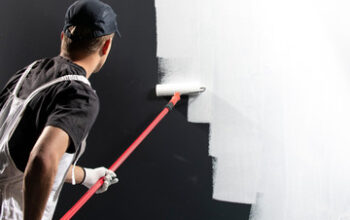Residential restorative painting is an essential aspect of maintaining the aesthetic appeal and structural integrity of a home. Over time, the exterior and interior of a house can become worn, faded, or damaged due to exposure to the elements, wear and tear, or simply the passage of time.
Restorative painting involves the process of revitalizing and renewing the surfaces of a home through painting, repairing, and refinishing. In this article, we will delve into the various aspects of residential restorative painting, including its importance, the process involved, and the benefits it offers to homeowners. You can also click here at https://bunburypaintingservice.com.au/ for more info.
 Importance of Residential Restorative Painting
Importance of Residential Restorative Painting
Residential restorative painting is crucial for several reasons. First and foremost, it helps to maintain the structural integrity of a home. The exterior surfaces of a house, such as the siding, trim, and windows, are constantly exposed to harsh weather conditions, including sunlight, rain, wind, and snow. Over time, this exposure can cause the paint to fade, peel, or crack, leaving the underlying surfaces vulnerable to damage. Restorative painting helps to protect these surfaces from the elements, preventing moisture from seeping in and causing rot, mold, or other forms of deterioration.
In addition to protecting the home from the elements, restorative painting also enhances its aesthetic appeal. A fresh coat of paint can transform the look of a home, making it appear more vibrant, welcoming, and well-maintained. Whether it’s updating the color scheme, covering up imperfections, or simply refreshing the existing paint, restorative painting can breathe new life into a house, boosting its curb appeal and overall value.
The Process of Residential Restorative Painting
The process of residential restorative painting involves several key steps, each of which is essential for achieving a high-quality and long-lasting result. Here are the typical steps involved in the restorative painting process:
- Inspection and Preparation: Before any painting can begin, a thorough inspection of the surfaces to be painted is necessary. This includes assessing the condition of the existing paint, identifying any areas of damage or wear, and determining the necessary repairs. Additionally, proper preparation of the surfaces is essential for ensuring the adhesion and longevity of the new paint. This may involve cleaning, sanding, filling in cracks or holes, and priming the surfaces as needed.
- Surface Repair: In many cases, restorative painting involves more than just applying a fresh coat of paint. Damaged or deteriorated surfaces may require repair work, such as replacing rotted wood, fixing damaged siding, or addressing water damage. These repairs are critical for addressing underlying issues and ensuring that the new paint will adhere properly and provide adequate protection.
- Color Selection: Choosing the right colors for a restorative paint job is an important decision. Homeowners may opt to stick with the existing color scheme or take the opportunity to update and refresh the look of their home with a new color palette. It’s essential to consider factors such as architectural style, neighborhood aesthetics, personal preferences, and any relevant homeowner association guidelines when selecting colors.
- Application of Paint: Once the surfaces are properly prepared and any necessary repairs are completed, the actual painting process can begin. High-quality paint, applied using professional techniques, is essential for achieving a smooth, durable, and attractive finish. Depending on the scope of the project, this may involve painting the exterior siding, trim, doors, windows, and other surfaces, as well as the interior walls, ceilings, and trim.
- Finishing Touches: After the paint has been applied, attention to detail is crucial for achieving a polished and professional result. This may involve touch-ups, clean lines, and ensuring that all surfaces are properly coated and protected. Properly finishing the job can make a significant difference in the overall appearance and longevity of the paint job.
Benefits of Residential Restorative Painting
There are numerous benefits to investing in residential restorative painting. Some of the key advantages include:
- Protection and Preservation: Restorative painting helps to protect the exterior and interior surfaces of a home from the damaging effects of weather, moisture, and wear. This can extend the lifespan of the underlying materials, reduce the need for costly repairs, and preserve the structural integrity of the home.
- Enhanced Curb Appeal: A fresh coat of paint can significantly enhance the curb appeal of a home, making it more attractive to potential buyers and increasing its overall value. Whether it’s updating outdated colors, covering up imperfections, or simply refreshing the existing paint, restorative painting can give a home a fresh and inviting look.
- Improved Aesthetics: Restorative painting allows homeowners to update and refresh the look of their homes, creating a more modern, cohesive, and visually appealing appearance. This can have a positive impact on the overall ambiance and atmosphere of the home, making it more enjoyable to live in.
- Increased Property Value: A well-maintained and visually appealing home is more likely to attract potential buyers and command a higher resale value. Restorative painting can be a cost-effective way to improve the marketability and value of a property, making it a worthwhile investment for homeowners.
- Longevity and Durability: Properly executed restorative painting can provide long-lasting protection and durability, reducing the need for frequent repainting and touch-ups. High-quality materials and professional application techniques can ensure that the paint job stands the test of time.
Residential restorative painting is an essential aspect of maintaining and enhancing the appearance and condition of a home. Whether it’s protecting the exterior surfaces from the elements, refreshing the interior spaces, or updating the overall look of the property, restorative painting offers numerous benefits for homeowners. By following a thorough and professional process, homeowners can achieve a high-quality, long-lasting, and visually appealing result that adds value and beauty to their homes.
Home restorative painting is a crucial aspect of maintaining and enhancing the appearance and condition of a house. Whether it’s the exterior siding, trim, doors, windows, or the interior walls, ceilings, and trim, restorative painting plays a vital role in protecting the home from the elements, preserving its structural integrity, and enhancing its aesthetic appeal. This article will delve into the importance of home restorative painting, the process involved, and the benefits it offers to homeowners.
The exterior surfaces of a home are constantly exposed to various environmental elements, including sunlight, rain, wind, and snow. Over time, this exposure can cause the paint to fade, peel, or crack, leaving the underlying surfaces vulnerable to damage. Restorative painting helps to protect these surfaces from the elements, preventing moisture from seeping in and causing rot, mold, or other forms of deterioration. By applying a fresh coat of paint, homeowners can ensure that their home’s exterior is shielded from the damaging effects of weather and wear.
In addition to protecting the home from the elements, restorative painting also enhances its aesthetic appeal. A fresh coat of paint can transform the look of a home, making it appear more vibrant, welcoming, and well-maintained. Whether it’s updating the color scheme, covering up imperfections, or simply refreshing the existing paint, restorative painting can breathe new life into a house, boosting its curb appeal and overall value. A well-maintained and visually appealing home is more likely to attract potential buyers and command a higher resale value.
The process of residential restorative painting involves several key steps, each of which is essential for achieving a high-quality and long-lasting result. It begins with a thorough inspection and preparation of the surfaces to be painted. This includes assessing the condition of the existing paint, identifying any areas of damage or wear, and determining the necessary repairs. Proper preparation of the surfaces is essential for ensuring the adhesion and longevity of the new paint. Surface repair may also be necessary, such as replacing rotted wood, fixing damaged siding, or addressing water damage.
Choosing the right colors for a restorative paint job is an important decision. Homeowners may opt to stick with the existing color scheme or take the opportunity to update and refresh the look of their home with a new color palette. It’s essential to consider factors such as architectural style, neighborhood aesthetics, personal preferences, and any relevant homeowner association guidelines when selecting colors.
Once the surfaces are properly prepared and any necessary repairs are completed, the actual painting process can begin. High-quality paint, applied using professional techniques, is essential for achieving a smooth, durable, and attractive finish. After the paint has been applied, attention to detail is crucial for achieving a polished and professional result. This may involve touch-ups, clean lines, and ensuring that all surfaces are properly coated and protected.
There are numerous benefits to investing in residential restorative painting. It helps to protect the exterior and interior surfaces of a home from the damaging effects of weather, moisture, and wear. This can extend the lifespan of the underlying materials, reduce the need for costly repairs, and preserve the structural integrity of the home. A fresh coat of paint can significantly enhance the curb appeal of a home, making it more attractive to potential buyers and increasing its overall value. Restorative painting also allows homeowners to update and refresh the look of their homes, creating a more modern, cohesive, and visually appealing appearance. Additionally, a well-maintained and visually appealing home is more likely to attract potential buyers and command a higher resale value.
In conclusion, residential restorative painting is an essential aspect of maintaining and enhancing the appearance and condition of a home. Whether it’s protecting the exterior surfaces from the elements, refreshing the interior spaces, or updating the overall look of the property, restorative painting offers numerous benefits for homeowners. By following a thorough and professional process, homeowners can achieve a high-quality, long-lasting, and visually appealing result that adds value and beauty to their homes.


